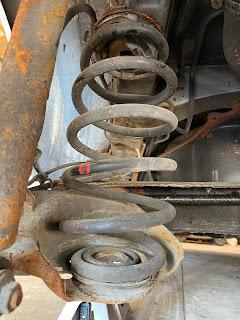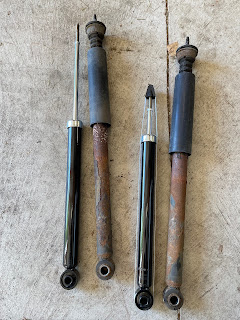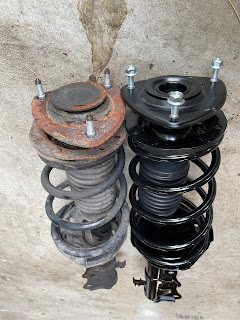Sunday, October 16, 2022
My 2005 Scion xB: Update #4
Sunday, April 24, 2022
My 1981 BMW 320i: Update #1
All differential seals, and O-rings replaced, plus cosmetic restoration.
This differential has been leaking fluid ever since it was installed. A mechanic years ago replaced the original diff that came with the car, for a used one, he had, saying mine had "clear signs of wear." 🙄 This one was "weeping" pretty much from day one. Not losing a huge amount of fluid, but unsightly, and leaving oil spots in my garage. I have never done any wrenching on differentials before, so here was my opportunity. I opted not to replace the bearings, as I think they were fine, and I didn't want to expand this project past what it was already.
You can see how dirty, and oily, the rear axle area is, from leaks that are at the pinion seal, and both output seals. Not doing their job, after 40 years.
Torque specs:
Project cost:
Total $216
Tuesday, April 5, 2022
In My Garage: 1981 BMW 320i
My 1981 BMW 320i, E21 ...The first 3 series
I'm finally getting around to adding this car to my blog. I bought this car in August of 2006. I flew out to San Francisco and bought it at a car dealer in Daly City. It had spent it's whole life in the Bay Area of California. It was, and still is, a rust free car. It had 199K on the odometer. Bought it for about $2,100 after taxes and fees. I drove it back to Milwaukee over 3 days. On the drive back, I discovered that the odometer was broken. I guessed, from looking at its history of mileage, during yearly registration, that it probably had about 260K miles on the car. The engine is a 1.8 liter, engine code = M10, factory crank HP 125. This is the same engine used, for at least the previous decade, in the BMW 2002, however by this point, it was fuel injected.
When I bought this car, I had very little wrenching know-how. So I have had a few different mechanics work on it, and it actually had been a challenge to retain technicians to work on it, simply because most shops have no interest in working on cars this old. I myself, will do as much, of the work as I can, going forward.
I probably had spent about $11-13K on parts and labor, for repair and upgrade work, since I bought it.
List of things done:
- front control arms replaced
- right rear fuel tank replaced (still leaks for a bit when filled up completely)
- both rear brake fluid cylinders replaced
- Ignition coil replaced
- used differential assembly replacement
- 1st custom Magnaflow exhaust (no cat)
- 4-1 stahl header
- custom exhaust redux
- A/C removal
- Bilstein shocks and H&R sport springs install
- changed wheel and tire package
- 320is factory front lip
- Rebuilt alternator
- both front caliper replaced
- another new passenger side caliper, a few years later (they seize for some reason)
- custom engine damper installed
- new horse hair drivers seat cushion from BMW
- drivers side repainted (just to clean up a few dings and imperfections)
- baseline plus after, dyno
Bought 5 BBS basketweaves, (that included one full size spare) they were the factory wheel that came on the 320is, of the same era, for $175 from a guy in Chicago. Also bought a 320is front lip off Ebay for $151




















































